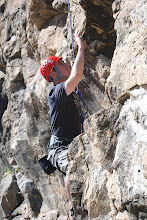 Some of the more interesting challenges with prosthetic limb travel happen outside the normal hotel stay situation.
Some of the more interesting challenges with prosthetic limb travel happen outside the normal hotel stay situation.Take for example the outdoor tree shower in the Mopito tented camp on the Serengeti. There were no handy hotel chairs or bathtub sides to rely on there! Lucky for me, the pressure was so weak that I could leave my prosthesis within arms reach and still not get it wet.
For the most part, there's nothing that you can't adapt easily to, however, a few handy items in your pack can make a world of difference.
Wet Launching: Canoes, Kayaks and Zodiacs
Most prosthetic legs have a content of metal in them however small it may be. In fresh water this isn't really an issue, however, being in the salt can quickly corrode those metal components. To be honest, I'm not all that bothered by this; bolts are cheap and carbon fibre doesn't rust; but when I can, I do try to take measures to protect it.
I have a few things in my bag of tricks for this one: a large plastic bag, a "Skins" compression sock and a bit of waterproof tape. I slip the leg into the bag, tape the open end shut against the socket and cover the whole lot with the compression sock (for pure sex-appeal).

(click to enlarge)
When I return from the day, I thoroughly rinse everything in fresh water, especially the silicon bits that invariably must get wet.
SCUBA Diving
 When I SCUBA dive, I like to take a few handy items: a child's snorkeling fin and long strips of double-sided velcro. I shove the small fin down the leg of my wet suit and fold up the excess material, strapping both to the end of my leg with the velcro strips.
When I SCUBA dive, I like to take a few handy items: a child's snorkeling fin and long strips of double-sided velcro. I shove the small fin down the leg of my wet suit and fold up the excess material, strapping both to the end of my leg with the velcro strips. It's not that I couldn't swim without the fin but diving is all about conserving your air so you can stay down there longer and see more stuff. The fin means I use far less energy to propel myself through the water. Less energy = more oxygen in the tank.
Bungee Jumping (and other intellectual pursuits)
Laying in my hospital bed, I was particularly worried I'd never be able to bungee jump, skydive or throw myself off anything fun ever again. I clearly wasn't the first! I was excited to learn that most bungee companies have switched from using ankle-only harnesses, opting in to the much more secure full body chest harnesses. A quick call to the operators will confirm whether or not they have this option available.
 In this case, I still recommend taking a long nylon strap with you. This is more for making the operators comfortable than for any practical purpose. I know in my case, I could hang upside down from my prosthesis all day and the suspension wouldn't fail... when it's fitting right... however, the operators may not be so confident and they're definitely going to notice the leg when they check your harness.
In this case, I still recommend taking a long nylon strap with you. This is more for making the operators comfortable than for any practical purpose. I know in my case, I could hang upside down from my prosthesis all day and the suspension wouldn't fail... when it's fitting right... however, the operators may not be so confident and they're definitely going to notice the leg when they check your harness.Tie one end of the nylon to the ankle and the other end to the leg strap of the harness. This ensures that if the leg did manage to come off (unlikely) it would simply dangle from the end of a long strap rather than plummet to the ground.
Camping
Sleeping outdoors in a tent is no different for me now than before the operation, with a few very minor differences:
1) keeping the OTHER foot warm (going solo is cold)
2) getting the leg on in a tent
The first one is easily solved by packing the bottom of the sleeping bag with extra insulating materials, typically my thickest sweater or a small neck pillow. Extra socks don't cut it. Alternatively, I suppose one could bring a hot water bottle but I'd but I'd be curious to see if that stays warm until morning.
The second one, getting the leg on, is just free entertainment for anyone nearby. All I can say for this one is twist, push, pull and get used to looking like an overturned turtle struggling to right itself!
Manual transmission vehicles
Believe it or not, manual transmissions aren't out of the question for me. As long as the clutch is more of a knee-driven pedal than an ankle driven pedal, I'm fine to take it for a spin.
 I only mention this here because many amputees never bother trying. I'm here to tell you, it's worth a try.
I only mention this here because many amputees never bother trying. I'm here to tell you, it's worth a try. If you can't drive, you can always use your leg as a cup-holder on the passenger side!












